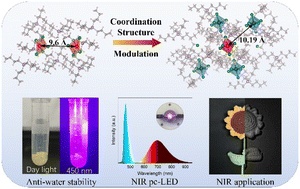Realizing Sb3+-activated efficient broadband near-infrared (NIR) emission under blue light excitation remains a significant challenge in lead-free metal halides. To overcome the above difficulties, a coordination structure modulation strategy was adopted, and the broadband NIR emission under blue light excitation was achieved in Sb3+-doped zero-dimensional (0D) organic tin(IV) bromide. Compared to the weak visible light emission with a photoluminescence quantum yield (PLQY) of 2.4% for pure (TBP)2SbBr5 (TBP = tetrabutylphosphonium), Sb3+-doped (TBP)2SnBr6 exhibits an efficient broadband NIR emission band at 705 nm with a PLQY of 33.2% upon 452 nm excitation, which stems from self-trapped exciton emission. Combined with experiments and theoretical calculations, we find that the large excited-state lattice distortion degree compared to the ground state and the narrow bandgap are dominant reasons for Sb3+-doped (TBP)2SnBr6 showing efficient NIR emission under blue light excitation. Specifically, Sb3+-doped (TBP)2SnBr6 also has excellent anti-water stability, existing stably in water for more than 4 hours while maintaining a high luminous efficiency. Based on the excellent stability and unique optical properties of Sb3+-doped (TBP)2SnBr6, a high-performance NIR light-emitting diode (LED) was fabricated by combining Sb3+-doped (TBP)2SnBr6 with a commercial blue LED chip, and its application in night vision was demonstrated.
